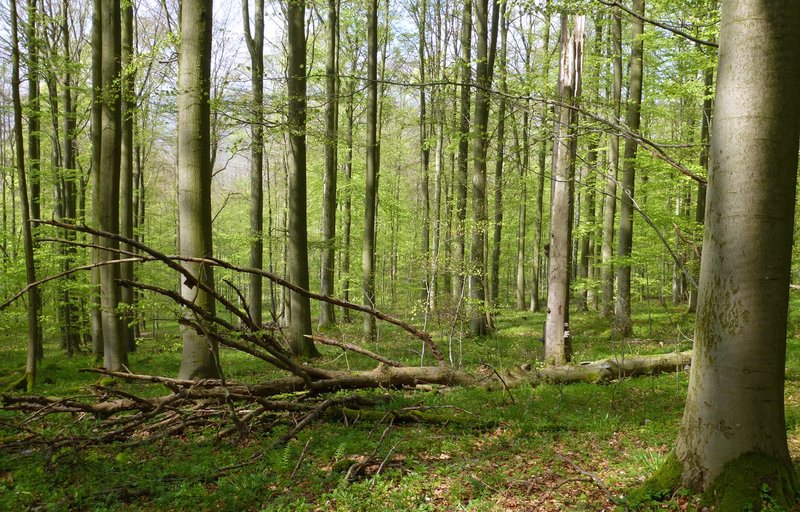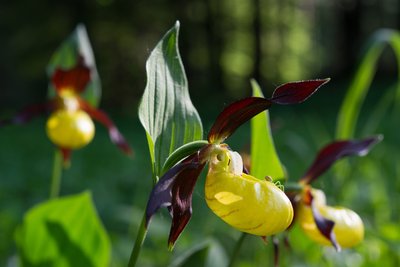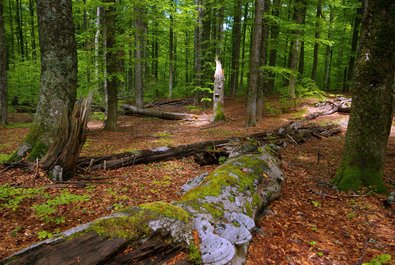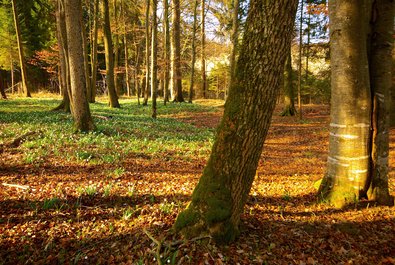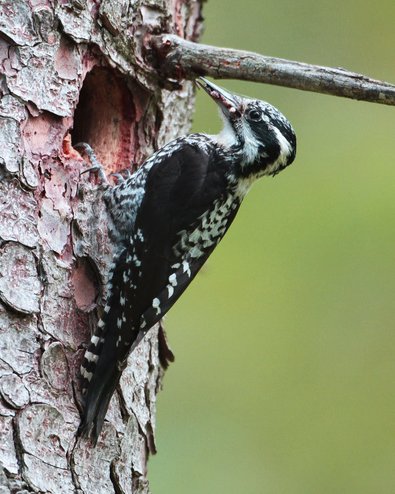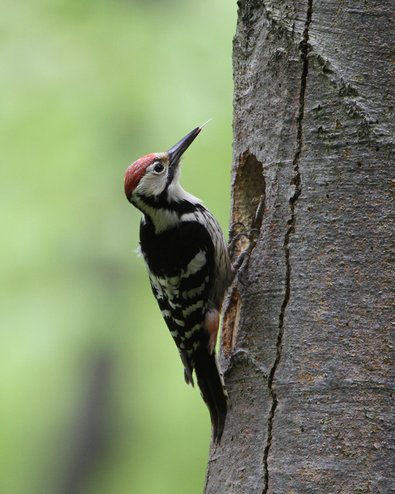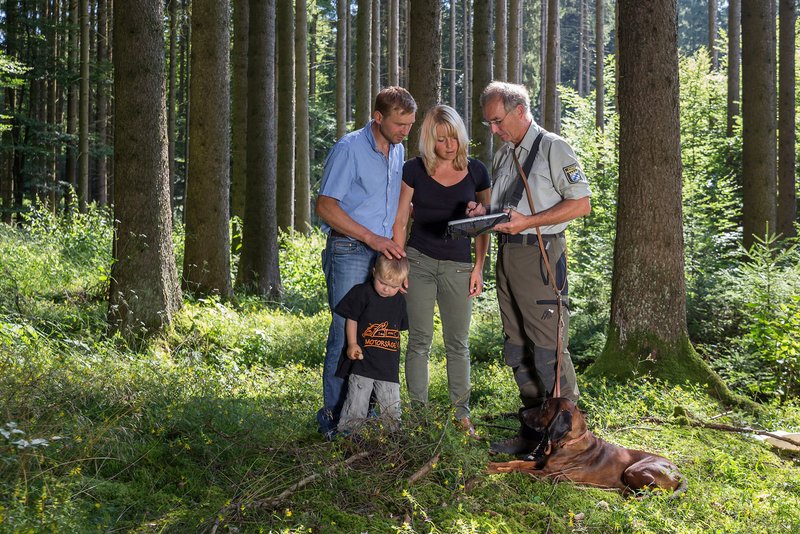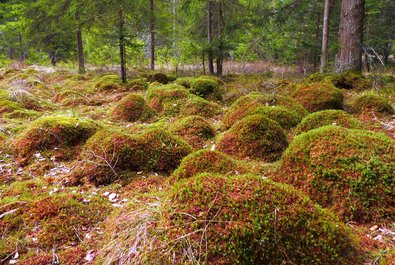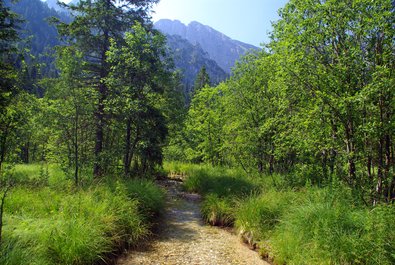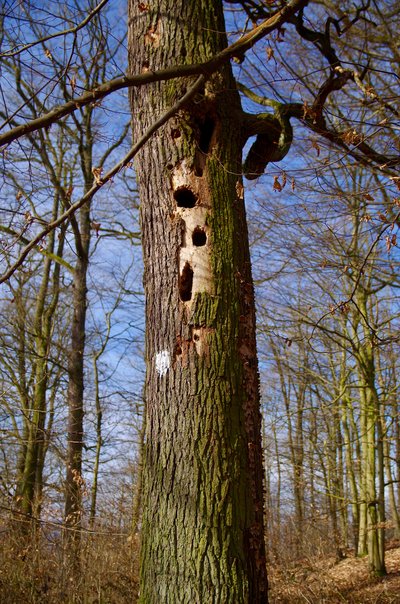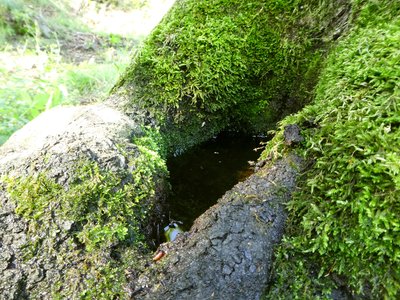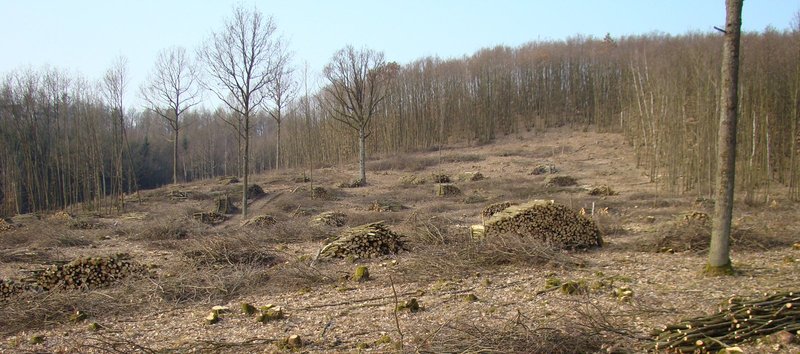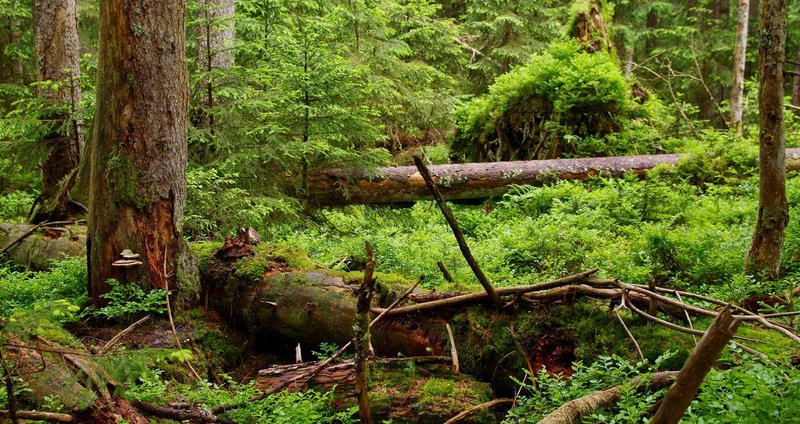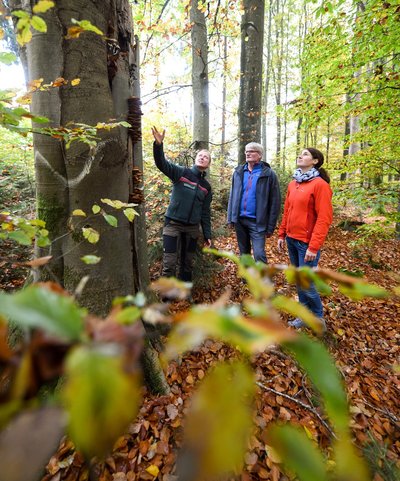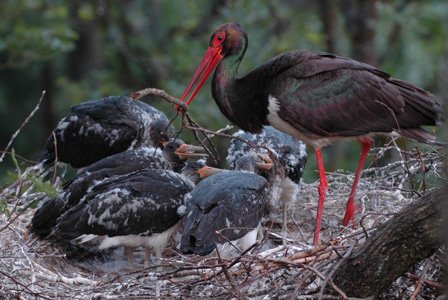Natura 2000 is the European Union’s network of protected areas and the largest conservation project in the world. As such it makes a major contribution towards protecting these valuable species and habitats. In Bavaria, the surveying of Natura 2000 protected areas is now almost complete. Findings from these protected areas can provide valuable guidance for the management and tending of all forests - not just Natura 2000 areas.
The legal basis of the European Union’s Natura 2000 ecological network is provided by the combined Habitats and Birds Directives (92/43/EEC and 2009/147/EC respectively). Natura 2000 consists of more than 27.000 designated protection areas, covering a total area of more than 780.000 km², and 18 % of Europe’s land area. That makes it the largest coordinated network of protected areas in the world. Member states are legally required to designate these sites and to place them under protection. The Bavarian contribution to Natura 2000 consists of 674 areas protected under the Habitats Directive, and 84 Bird Protection Areas (also known as Special Protection Areas/SPAs). These cover a total area of some 8.000 km², or 11 % of Bavaria’s land area. Forest cover dominates in these areas, at 56 % of the total; forests thus play a key role in the conservation of biological diversity in Bavaria.
Everything revolves around a “favourable conservation status”
The two EU directives mentioned determine the procedures and steps necessary to safeguard species and their habitats within the EU. The annexes of the directives are essential components listing the Natura 2000 objects of protection. Annex I 92/43/EEC covers the habitats to be protected; and Annexes II, IV, V of 92/43/EEC and Annex I and Article 4 (2) of 2009/147/EC cover the species to be protected. The objective is to maintain or restore the “favourable conservation status” of these habitat types and species. The member states are obliged to specify conservation measures necessary to maintain or restore the favourable conservation status of the listed objects of protection. An individual species has a favourable conservation status for example if:
- its natural range is not shrinking;
- it is a viable element in its natural habitat; and
- the habitat is large enough to allow the populations to survive in the long term.
Forest habitat types and forest species with special responsibility
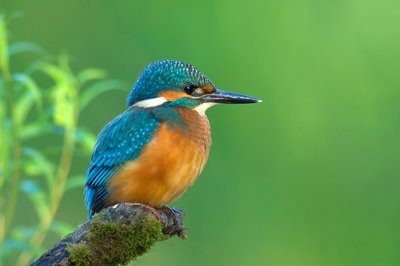
Fig. 3: The kingfisher (Alcedo atthis) is a keystone species of our flowing rivers and streams (Annex I of the Birds Directive). It breeds in burrows that it excavates itself in the steep banks of rivers and streams. Branches protruding over the water are important as perches from which it dives to seize small fish (Picture: Rudolf Vornehm).
In Bavaria, 16 forest habitat types, 42 forest bird species and more than 50 Habitats Directive species relevant to the forest are protected by the directives. They are representative of the native species and habitats of our forests. The 16 woodland habitat types thus cover most native forest societies and legally protected woodland biotopes; the selected species are representative of the many species of animals and plants. Their role as “representatives” becomes clear when you consider that there are 46.500 animal species native to Germany, and between 4.200 and 5.900 species are to be found in managed beech forests alone. For forest conservation to be effective, it is essential to identify a “set” of selected umbrella, indicator, or keystone species. With their help, key habitat structures and habitats can be identified and protected at different spatial levels.
Report on the state of nature - conservation status and action required
The member states of the EU are obliged to report every six years on the status of habitat types and species of common interest. For this purpose, standardised, systematic nationwide monitoring is carried out. For the habitat types, the natural distribution, the area actually occupied, specific structures and functions (species inventory, habitat structures), and the prognosis for the future are assessed. For the species, population size and habitat are relevant, as are their distribution area and prospects for the future.
Fortunately, especially the extensive beech habitat types, such as sweet woodruff-beech, woodrush-beech or orchid-limestone-beech forests currently have a favourable status of conservation. This is all the more significant given our special responsibility for them as a listed UNESCO World Heritage Site. These forest societies take up a good three quarters of the area covered by forest habitat types in Bavaria.
Figs. 4 and 5: Beech forests of all age-classes naturally dominate the forest landscapes of central Europe; left: Woodrush-beech forest, right: Wood barley (Hordelymus europaeus)-beech forest (Pictures: Boris Mittermeier).
In contrast, bog, floodplain and pine habitat types generally have an unfavourable status. They urgently require active conservation measures. And yet the species-rich riparian habitats in particular play a key role in connecting biotopes in the cultural landscape. Because of their richness of structure and the large number of species they support, oak forests are also considered to be “gems” of nature conservation. At the moment, their conservation status in the protection areas is often still rated as “favourable”. And yet the oak is often not represented when it comes to the rejuvenation of stands, i.e. in the next generation of trees. The prognoses for these habitats, which are man-made in many places in Bavaria, are thus uncertain.
In the case of species closely linked with woodlands, the results reported are much more complex than for the habitat types. The population sizes of species that live in semi-open, sparse, rather meagre habitats, i.e. in the marginal biotopes between forest and open countryside, are frequently at risk in our cultural landscape. By contrast, the surveying shows that the population developments in species from old forests rich in deadwood and biotopes have usually been stable or even positive in recent decades. Although the populations are sometimes relatively small, they have often been significantly underestimated in the past. This is also true for particularly valuable bird species such as the middle spotted woodpecker, the Eurasian three-toed woodpecker, or the white-backed woodpecker in the alpine region, or the more demanding collared flycatcher (Ficedula albicollis) and pygmy flycatcher (Ficedula parva). Despite the fragmentation of the populations of these cavity and niche-nesting birds for historical reasons, their populations have in fact stabilised in recent decades.
Priorities in forest conservation
A review of the results of the Habitats and Birds Directives progress reports and the data available for extensive areas in the Natura 2000 management plans reveals clear priorities for action on forest conservation. These are reflected in the following topics:
- Diversity of endemic tree species
- Deadwood, habitat trees, forest development phases
- Historical forms of forest use
- Regional responsibility
- Climate change
Diversity of endemic tree species
The first priority is to preserve or re-establish endemic forest societies with their characteristic diversity of tree species and structures. The forest conversion measures of recent decades can be considered a great success in terms of forest conservation. The proportion of deciduous trees increased between 1971 and 2012 from 22 % to 36 % of the forest area, for example. If we take into account the long growth and production periods in the forest, this increase in the proportions of deciduous trees can be seen as a huge achievement by foresters and forest owners. Nevertheless, the figures also show that the biggest proportion of the area is still stocked with non-endemic coniferous species. We must therefore continue consistently to implement forest conversion measures.
The Natura 2000 definitions of forest habitat types provide guidance on which tree species are typical of a forest society and what proportion of the tree species composition they should make up in these habitat types. As well as the minimum shares of dominant tree species, it is important to consider the secondary and pioneer tree species. Species of oak, birch, willow or poplar are particularly valuable host plants for many animal species and thus increase biodiversity significantly. As these tree species are often particularly vulnerable to browsing, a strict hoofed game management strategy is extremely important for the protection of these habitat types.
As well as the extensive zonal forest societies, the azonal habitats are biotopes particularly worthy of conservation. These are forest societies on special sites, for example bog forest, scree forest, ravine forests and riparian forests. Because of the extreme site conditions, they host a specific range of species adapted to these special structures. As habitats like this naturally also tend to be small and often isolated in the landscape, the species communities associated with them are often particularly vulnerable. If forest communities like this are managed, tending measures must be carried out with particular care and require a high level of both conservation and forestry expertise.
Deadwood, habitat trees and forest phases with sparse cover
In managed forests in earlier centuries, forest phases with old and decaying trees as well as disturbed areas and early succession phases only took up a small proportion of the area. Species dependent on these phases have become rare in our forests as a result. Today, deadwood and habitat tree concepts are therefore an indispensable part of any forest conservation plan. It is especially important to promote standing, large-diameter deadwood and habitat trees in the area wherever possible, and to include as many microhabitats as possible (cavities, cracks for animals to live in, crown deadwood, etc.). Some highly specialised species with extremely high demands in terms of deadwood and habitat trees also need suitable places to take refuge.
The key thing for most species however, is that managed forests integrate several habitat trees per hectare over large areas. On a small scale, they imitate the structural richness of natural central European mixed deciduous forests, in which ageing and decaying phases would normally be found on every hectare. This also provides a network of associated habitats for species that do not spread far and that are dependent on such structures, and thus helps to prevent populations becoming isolated. It has for example been established that the middle spotted woodpecker, the species among our native bird species for which Germany bears most responsibility worldwide, needs at least six habitat trees per hectare to provide it with an adequate habitat.
Historical forms of forest use
Sparse forest phases - i.e. old trees and sun-drenched ground vegetation rich in species next to each other - have become rare in the cultivated landscape. Historical forms of forest use, such as coppice with standards or forest pastures and pannage, are thus valuable replacement habitats for species dependent on forest phases with ageing and decaying trees and fringe biotopes. It is also the case that these historical forms of forest use have to a certain extent outlasted the centuries, so habitats have also been maintained for species that do not spread easily. This is why these intensively used forests in particular are now conservation “arks” for rare forest species, which must be preserved through targeted, active management measures. However, it is crucial here that the forests not only allow light in, but that they also contain a high proportion of old trees, and that where possible, the resulting deadwood is left in the stand.
Taking “regional” responsibility
The natural landscape in Bavaria today owes its heterogeneity to the use that has been made of its forests over millennia, and to the multitude of people who have managed and worked them. This becomes clear if we compare the distribution of the habitat types and occurrence of species in different administrative districts (Figures 14 and 15). Actually, diverse beech forest communities would normally dominate as the potential natural vegetation (pnV) on more than 80 % of Bavaria’s land area. Today, however, beech forests are mainly only to be found in the north-west and southern areas of Bavaria (Figure 14).
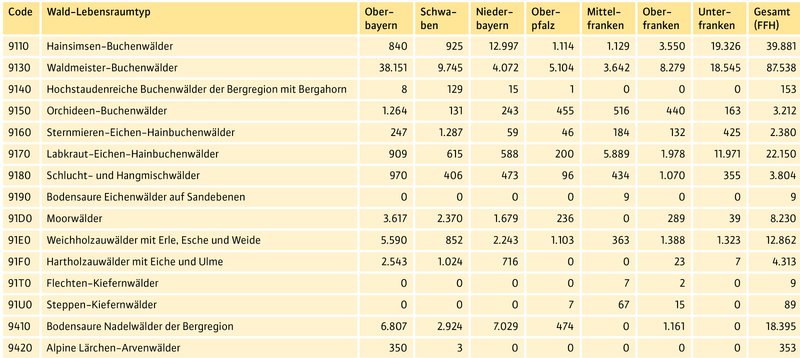
Fig. 14: The surveying of forest habitat types in the Habitats Directive areas reveals strong regional differences. Lower Franconia (Unterfranken) is thus home to the most woodrush-beech (9110) and galium-oak-hornbeam (9179) forests in Bavaria, whereas bog forests (91D0), softwood alluvial forests (91E0) and hardwood alluvian forests (91F0) are predominantly to be found in Upper Bavaria (Oberbayern). (Survey as of: 21/03/2021)
The transformation of the forest landscape is particularly striking if we consider the Upper Palatinate (Oberpfalz) region as an example. In this “industrial heartland” of the Middle Ages, the forests were intensively used, particularly for iron smelting. The resulting degradation of the soils led to the large-scale planting of pine across extensive areas. For historical reasons, the area covered by special habitats today in the Upper Palatinate is therefore small. In the extensive, little-disturbed forest landscapes of eastern Bavaria, on the other hand, many once extinct species have been able to re-establish themselves in recent decades, including the white-tailed eagle (Haliaeetus albicilla), the osprey (Pandion haliaetus), the common crane (Grus grus), and the common otter (Lutra lutra).
It should however also be borne in mind that habitats that still occur over relatively large areas on a regional basis, and thus appear to their local owners to be “nothing special”, may in fact be rare in a Bavarian-wide context. These areas include the grey alder (Alnus incana) forests along the River Inn, the areas of coppice with standards in the southern Steigerwald forest, the high altitude spruce forests in the alpine region, and the hardwood riparian forests along the River Danube. For the maintenance of biological diversity it is thus important to look at the peculiarities of each region, and to bear in mind the place of these forests in a Bavarian-wide context.
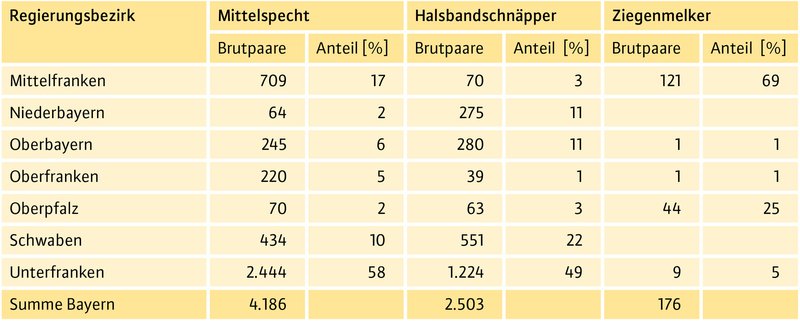
Fig. 15: The numbers of breeding pairs of middle spotted woodpecker, collared flycatcher (Ficedula albicollis) and nightjar in Bavaria’s administrative districts, and their percentages of the total populations in Bavaria (derived from the maximum values of the “Bavarian breeding birds atlas”) [Rödl et al. 2012]).
This regional aspect is not only apparent for the habitats, however, but also for the species: If we compare the distribution of forest species as given in the relevant distribution atlases, it becomes clear that regional responsibilities can be very different (Figure 15): 58 % of all breeding pairs of middle spotted woodpecker and 49 % of all breeding pairs of collared flycatcher in Bavaria are to be found in Unterfranken (Lower Franconia). Mittelfranken (Middle Franconia), on the other hand, is home to 69 % of the breeding pairs of nightjar. General silvicultural concepts implemented across Bavaria or even nationwide thus often do not do justice to the local situation.
The challenge of climate change
The damage caused over extensive areas of our forests by drought in recent years makes it clear that, in times of climate change, we can expect an increase in extreme weather situations and thus also natural “disturbances”, such as drought damage, windthrow and insect disasters. These changes will accordingly also have a major impact on habitat types and communities of species. It can be assumed that more than half of all habitats in Germany will have a negative reaction to climate change, and that only a third will be less vulnerable.
Similarly, there are likely to be large displacements in area for many species, assuming they are sufficiently mobile to keep up with the changes. For bird species, for example, all ranges are expected to shift an average of 550 km in a northern or north-eastern direction. As well as suitable climate conditions, this does however also require that there is an “available habitat structure” at the “point of arrival”. Especially in forests, however, the outcome of this race against time is uncertain, because of the slow dispersal mechanisms of many tree species.
Nevertheless, experts currently assume that beech forests, and in future increasingly also oak forests, will continue to characterise the landscape. They also assume that the current diversity of tree species means that the forest management risk will be relatively low on three quarters of the forest area. In active conservation, the only recommendation we can possibly make is to ensure that the diversity of tree species typical of the habitat is fully exploited - meaning that the more heat-tolerant secondary species should also be actively promoted in mixed beech forests.
The preservation of genetic diversity is an important aspect here. The natural regeneration of genetically more diverse stands with species that are well adapted to the site and thus with the relevant natural selection is the best guarantee for a better adapted future generation of trees. The concept of “assisted migration”, by which tree species that do not spread easily are introduced to areas they would not reach quickly enough through natural migration, appears to be both necessary and promising. Very well developed habitat types with good prospects for development at least in the mid-term should not however be included in “assisted migration” measures. Especially in these areas, the introduction of alternative, non-native tree species should be avoided.
Deadwood and habitat trees are key structures in forests and should be maintained. Habitat tree characteristics, particularly in beech, do not generally develop until the stand is relatively old. On the other hand, the operational risk of raising the harvesting age of the trees in times of climate change is very high. In order to maintain a rich diversity of structures in the forest, it is thus necessary to retain a network of habitat trees across the area even with decreasing rotation periods. It is also important to ensure that biotopes are connected, because species can only “migrate” within the landscape if the habitat structures are distributed over a large area.
As the reactions of ecosystems to disturbance events are never unequivocally predictable, an adaptable management style seems the most suitable approach to dealing with the uncertainty of climate change. This means that set targets, such as the population size of a particular species or the desired species composition of a habitat type, must be reviewed continually. For this there must also be an ongoing, adapted monitoring system, to allow for a rapid response to changes.
Achievements and outlook
Thanks to surveying both inside and outside the protected areas, information on habitat types and the occurrence of species is now available for large areas. The management plans for the Natura 2000 areas also describe concrete measures to be taken to maintain or improve diversity in the landscape.
The Natura 2000 management plans, which were put together by the Bavarian forestry and environmental authorities and in consultation with all key stakeholders, are published on the internet and can be downloaded from the homepage of the [Bavarian] State Office for the Environment (“Landesamt für Umwelt”). Many things learnt from the management of protected areas can be applied to other forest areas. Foresters from the Offices for Food, Agriculture and Forestry (ÄELF) will also provide advice and support for Bavarian forest owners on conservation issues. Various attractive subsidy programmes for private and corporate forests are also administered by the ÄELF. The foresters also have the support of the Forestry Conservation Offices on issues to do with conservation. These are to be found at one particular AELF with this focus in each administrative district, and supported by experts from the Bavarian State Institute of Forestry (LWF). These measures in private and corporate forests are complemented by the designation of “natural forests” on 10 % of the state forest area, but especially also by far-reaching nature protection concepts in the state forests.
Thanks to the interplay of these diverse plans, measures and subsidies in the different forest ownership types, a significant contribution is being made towards the maintaining of species diversity in Bavaria’s forests. This goal has been followed now for decades, and must continue to be pursued consistently in the future.
Summary
The large-scale surveying of Bavarian Natura 2000 protected areas shows both a need for action, and successes in forest nature conservation. The priority here is the conservation of endemic forest communities, with their characteristic diversity of structures and species. Whereas extensive areas of beech forest communities have a favourable conservation status, habitats that have resulted from human intervention in the past, such as lichen-pine forests, are dependent on active support measures. The forest landscape in Bavaria owes its present-day diversity to the different uses made of it in the past. Forest conservation concepts must address regional differences and integrate them in a concept for the whole of Bavaria.

